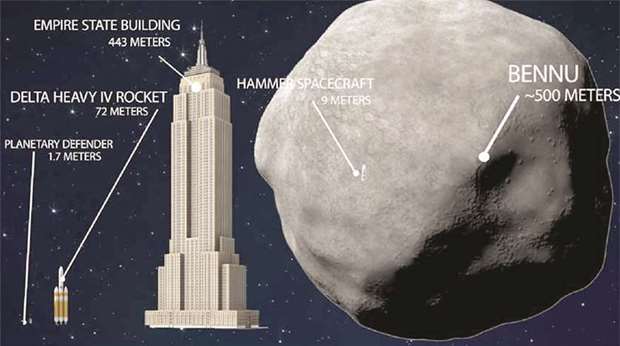You would be forgiven for not worrying about what might happen on September 25, 2135.
Scientists are worried, though, since there’s a chance — albeit only 1 in 2,700, according to current calculations — that an asteroid taller than the Empire State Building and 1,664 times as heavy as the Titanic will hit the Earth.
If it does, it’s estimated that the kinetic energy of the impact would be equivalent to 1,200 megatonnes — 80,000 times the energy of the atomic bomb dropped on Hiroshima — so you would also be forgiven for being glad that you won’t be around for the fireworks.
“The chance of an impact appears slim now, but the consequences would be dire,” said Kirsten Howley, a physicist at the California-based Lawrence Livermore National Laboratory (LLNL), which applies science and technology in the service of US national security.
LLNL scientists are part of a “national planetary defence team,” including the US space agency Nasa, the National Nuclear Security Administration and Los Alamos National Laboratory, that has designed a conceptual spacecraft to deflect Earth-bound asteroids. The team has evaluated whether it would be able to knock off course 101955 Bennu — the massive asteroid that could strike in 2135.
Nasa ranks Bennu among the most dangerous of the more than 10,000 near-Earth objects detected to date. To learn more about the potential killer rock, Nasa launched in 2016 the spacecraft OSIRIS-REx — an acronym of Origins, Spectral Interpretation, Resource Identification, and Security–Regolith Explorer — to map it and return a sample. Costing about a billion dollars, it’s the first such mission by the US.
Originally known as 1999 RQ36, the asteroid was renamed Bennu — after an ancient Egyptian deity usually depicted as a grey heron — by a 9-year-old American boy in a 2013 contest.
Carbon-rich and thought to perhaps contain organic materials or molecular precursors to life, the space rock is about 500 metres in diameter, weighs some 79 billion kilograms and is circling the sun at a speed of more than 100,000 kilometres per hour.
It comes close to the Earth every six years.
OSIRIS-REx is expected to begin its approach in August before reaching Bennu in December. The spacecraft will use its five onboard instruments for remote sensing and scanning the surface of the asteroid to establish its composition. In 2020, it’s scheduled to collect between 60 grams and 2 kilograms of surface material with its robotic arm, and then return to Earth in 2023.
Knowing Bennu’s physical and chemical properties will help scientists in developing a defence strategy against it if necessary.
The spacecraft conceived by US scientists to possibly deflect Bennu – dubbed HAMMER, short for Hypervelocity Asteroid Mitigation Mission for Emergency Response vehicle – is 9 metres tall, weighs 8.8 tonnes and features a modular design that would enable it to serve as either a ‘kinetic impactor’ — essentially a battering ram — or as a transport vehicle for a nuclear device.
The preferred method, the US scientists say, would be to ram the asteroid off a collision course with Earth — but not so hard that it breaks apart. The nuclear deflection approach, unlike the portrayal in the 1998 US film Armageddon, would involve detonating a nuclear explosive some distance from the asteroid.
In a paper published recently in the journal Acta Astronautica, the scientists note that if the decision was made to deflect Bennu, it would take at least 7.4 years to build the spacecraft, plan the mission and travel to the asteroid. Delay would greatly complicate mitigation, since the strength of the shove needed to sufficiently change Bennu’s trajectory increases the closer it gets to Earth. The scientists estimate that seven to 11 launches of single HAMMER impactors would be needed 25 years before a projected impact with Earth, compared with 34 to 53 launches for a 10-year lead time.
While the scientists’ paper didn’t include simulations of nuclear deflection scenarios, which are to be published in the near future, they say their findings suggest that the more powerful, nuclear option may be required for larger objects like Bennu, as it can effect a greater change in speed and trajectory.
Though Bennu could kill many living things on Earth, it may hold clues to how life got here in the first place.
“We’re going to Bennu because we want to know what it has witnessed over the course of its evolution,” said Edward Beshore, deputy principal investigator for Nasa’s OSIRIS-REx mission.
“Bennu’s experiences will tell us more about where our solar system came from and how it evolved.
“Like the detectives in a crime show episode, we’ll examine bits of evidence from Bennu to understand more completely the story of the solar system, which is ultimately the story of our origin.” – DPA

ILLUSTRATION: This handout illustration shows the size difference between the Bennu asteroid threatening Earth and the HAMMER defence system being developed by scientists.
